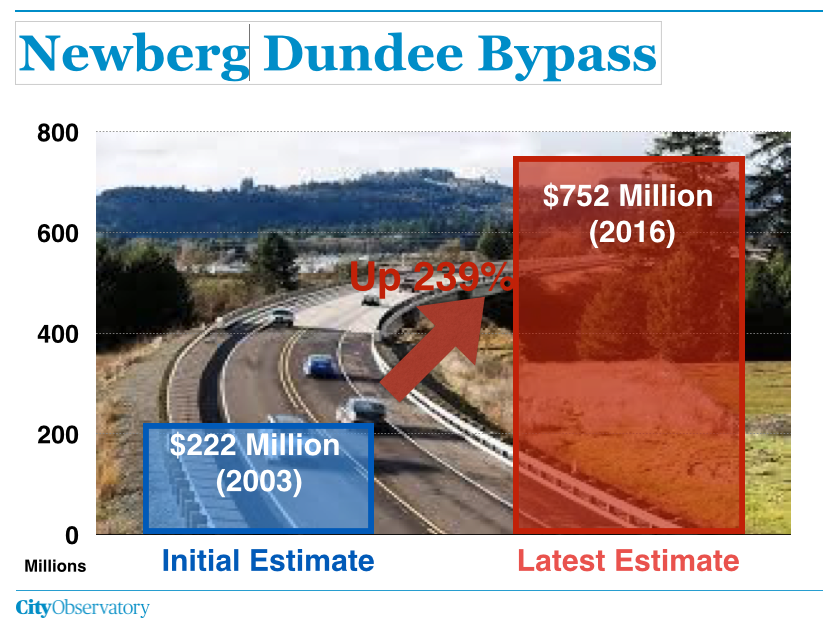What City Observatory Did This Week
Beware of phony claims that highway projects are “On-time and Under-Budget.” For highway departments, the key to being on-time and under-budget is Orwellian double-speak.
Oregon DOT projects are always on-time and under budget–because the agency simply “disappears” its original schedules and budgets. Delayed, half-finished projects are officially described as “On-time and on-budget.” For example, when ODOT opened the first phase of the Newberg-Dundee bypass in 2017, it claimed the project met schedule and budget, even though it was years late, cost considerably more than its original budget, and was less than half-finished.
Must Read
Proximity trumps mobility. Transportation engineers obsess about making things go faster, but in the real world, optimizing systems for speed just generates more sprawl and longer travel distances. The Victoria Transportation Policy Institute’s Todd Litman has a compelling essay at Planetizen underscoring why we need to be paying attention to having destinations close at hand, rather than scurrying to go ever faster.
There are a growing range of tools that help us measure and visualize accessibility. As an example Litman uses this heat map of Walk Score for the Chicago region–dark green areas, principally near the city’s Loop have the highest levels of walkability, with many common destinations nearby.
Litman concludes this will require sweeping changes in the way we plan and organize:
To create complete, affordable, livable, healthy, and sustainable communities we need to change departments of transportation that focus on moving vehicles into departments of accessibility that create compact, multimodal neighborhoods where the need for motor vehicle travel can be minimized.
Selling speed. Car ads routinely feature people driving dangerously or illegally, usually with a miniscule disclaimer (professional driver, closed course). The fantasy of single reckless driver on an otherwise empty road is a long established theme of such ads. The Insurance Institute for Highway Safety points out that we’ve long since banned (or shamed) such anti-social behavior from advertising for other products, but its still widely practiced by automakers–notwithstanding the fact that driving kills more than 40,000 Americans annually (with a high fraction of these deaths attributable to excess speed. IIHS argues:
Advertisers must treat unsafe speed the same way they would treat drunk driving or failure to use a seat belt — behaviors they wouldn’t think of showing in a positive light. The thrill of moving at extreme speeds should be confined to amusement parks and virtual reality games. Today’s vehicles are more reliable, more efficient, more comfortable and safer than ever before. Shouldn’t that be enough of a selling point?
A climate busting turnpike plan in Maine. Like most state’s, the biggest source of climate pollution in Maine is transportation. In spite of a much heralded “Maine won’t wait” climate strategy, the state’s turnpike authority (led by the Governor’s brother) is planning a quarter billion dollar expansion that will only make climate pollution worse. Writing at the Press-Herald,Christian MilNeil points out the hypocrisy;
The Maine Turnpike is already the worst polluter in Vacationland, according to Turnpike annual reports and EPA data. It will be mathematically impossible for Maine to meet its climate goals without major changes to how the Maine Turnpike operates. Unfortunately, Turnpike leadership appears to be in denial of these facts. Instead of reducing traffic, the body wants to spend a quarter of a billion dollars of public funds to subsidize even more traffic on a new highway to Gorham – a boondoggle that will considerably increase traffic on connecting roadways and make Mainers’ commutes even longer.
Too many state climate plans are pledges to be met at some distant future date; meanwhile an entrenched and well-funded bureaucracy continues to double down on transportation spending the makes it even harder to meet climate commitments.
New Knowledge
Where new housing supply is located matters to affordability. There’s mounting economic evidence for the fact that increasing housing supply helps moderate or reduce rents. A new study from Harvard’s Kennedy School suggests that building more housing in the center of cities and closer to low and moderate income households facing affordability challenges pays the biggest returns to improving affordability.
The study examines the critical role of “vacancy chains”–the series of moves that are triggered by construction of new housing. When a new home is built, a household moves in, and that creates a vacancy where they used to live. Each new home gives rise to a series of moves, and creates vacancies in other locations, and ultimately in different price tiers of the market–new market rate housing produces vacancies in lower priced market segments.
French and Gilbert look at the geographic variations in these moving chains, and find that the construction of new homes in suburban and exurban locations produces fewer vacancies in central cities and more affordable neighborhoods than does construction of new homes in more urban and central locations. As they write:
. . . residential vacancy chains initiated by new low-density suburban single family housing end quickly, before they can reach the urban neighborhoods in which residents are most exposed to rising housing costs. This descriptive feature of vacancy chains, when viewed in light of our simulation results, suggests that the non-local price effects of new housing supply are concentrated in nearby submarkets and that the incidence of the benefits of additional housing therefore depends crucially on what kind of housing is built and where.
The practical implication of this study is that building more housing in central cities, and relatively close to places where low and moderate income households are located will have greater efficacy in promoting housing affordability than simply adding more homes at the urban periphery.
Robert French and Valentine Gilbert, Suburban Housing and Urban Affordability: Evidence from Residential Vacancy Chains, Harvard Kennedy School† April 18, 2024



